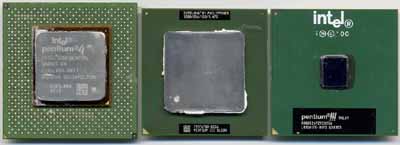Intel Pentium III 1.2GHz 0.13-micron Tualatin: The Celeron of the Future
by Anand Lal Shimpi on July 30, 2001 3:30 AM EST- Posted in
- CPUs
Cool Runnings: The Intel Bobsled Team
The Pentium III 1.2GHz processor runs off of a 1.475V core voltage, which is
16% lower than the 1.75V core voltage of the
At 1.2GHz the Tualatin core produces 29W of heat, which is less than the 33W the 0.18-micron Pentium III dissipates at 1GHz. Most of today’s higher speed 0.18-micron processors produce in the 50W+ area. The cooling requirements reflect this cool operating capability.

Click to Enlarge
From Left to Right - Pentium 4, Pentium III (Tualatin), Pentium III (Coppermine)
In order to distribute the heat generated from the small 0.13-micron core over the base of the CPU’s heatsink, Intel outfitted the new Pentium III with an Integrated Heat Spreader (IHS). This is known as the FC-PGA2 packaging; previous Socket-370 Pentium IIIs used a regular FC-PGA package.
The Pentium III’s IHS is a lot like the IHS that is present on the Pentium 4, the only difference being that it is heavier because of the smaller Pentium III core. This is a page from Intel’s book that AMD definitely needs to have a look at. The 0.18-micron Athlon (Thunderbird core) should have debuted with an IHS since entirely too many users have cracked their Athlon cores by improperly mounting a heatsink.
The 0.13-micron Athlons due out later this year had better feature some sort of an IHS otherwise there are going to be many more cracked cores out there, especially with a smaller, more fragile 0.13-micron core.
Putting the die savings to use: The Pentium III-S
One of the biggest benefits of moving to a smaller circuit size - in this case moving from 0.18 down to 0.13-micron - is that the die size of the processor core is cut virtually in half. This opens up the potential for additional items to be introduced to the processor core, such as data prefetch logic or, in the case of the server version of the Tualatin based Pentium III, more L2 cache.
The Pentium III-S uses the same Tualatin core as the desktop Pentium III, but includes a larger 512KB L2 cache for server applications. The larger L2 cache comes in handy in database serving applications among other things. While we couldn’t get a Pentium III-S in time for this review, we will attempt to provide as much information about the processor as possible.
The architecture of the Pentium III-S should be identical to the Pentium III (Tualatin), with the exception of the larger L2 cache. Both L2 caches are 8-way set associative, so the Pentium III-S is indeed a different die. There has been speculation that the Pentium III-S has a wider L2 cache bus and/or is capable of sustaining higher bandwidth to the L2 cache, but we have yet to confirm this.
The Pentium III-S also requires a compliant chipset/motherboard as well as proper BIOS support.










0 Comments
View All Comments